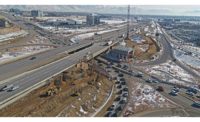Utah has received a grade of C+ on the state’s overall infrastructure report card, not an improvement from the last report issued five years ago, but neither was it worse, which has been the case in many states. The Infrastructure Report Card was issued by the Utah Section of the American Society of Civil Engineers. It shows the state holding steady in the face of record population growth and multiple systems that are reaching the end of their intended lifespans.
“Citizens in Utah can be very proud. Even though this could be looked at as just a C+ grade, it is actually one of the highest in the nation,” said K.N. Gunalan, 2020 ASCE national president. Utah tied with Georgia, which also received a C +, the highest cumulative grade ASCE has issued to any state.
Other individual sector grades for Utah are: aviation (C), bridges (B+), canals (D+), dams (C+), drinking water (B-), hazardous waste (C+), levees (D-), roads (B+), solid waste (B-), stormwater (C+), transit (B+) wastewater (C). The full report will be released in early January.
The above-average score was similar to those issued in recent years to neighboring states. ASCE has issued C- grades to Idaho and Colorado and a grade of C to Arizona and Nevada.
“The C+ grade indicates mediocre condition, with signs of deterioration in some areas, but the level of investment and oversight has been successful at maintaining systems to meet current needs,” said Craig Friant, past-president of the ASCE Utah Section and chairman of the report card committee.
Utah’s roads, bridges and transit systems scored the highest, each receiving a grade of B+, while canals and levees were the lowest, a D+ and D- respectively.
“Utah is home to some of the best-performing transportation infrastructure in the nation,” said Friant, noting that only 4.2% of the state’s roads are considered to be in poor condition.
“That’s played a strong role in attracting business opportunities,” he said, citing the recently completed I-15 Technology Corridor project in Lehi south of Salt Lake City. The corridor has become a regional hub for high-tech companies like Adobe, Oracle and Vivint. The project widened I-15 from four to six lanes, as well as rebuilding two interchanges and constructing 17 bridges.
“We’ve prioritized the funding of the state’s nearly 50,000 miles of roads, increasing funding levels from $1.2 billion in 2017 to $1.7 billion in 2020,” said Friant.
“This is really good news to anyone who drives in our state. It speaks to the leadership of our state and the value they put on transportation,” said John Gleason, public information officer for the Utah Dept. of Transportation. “I think 20 years ago, we’d be having a different conversation, but since that time, we’ve undertaken projects to almost completely rebuild I-15 along the Wasatch Front.”
Health of State's Bridges Improving
Friant noted that since the last report card five years ago, the state has seen a 40% decrease in the numbers of structurally deficient bridges. “We’ve gone from 2.9% in 2015 to 1.7% in 2020, and that is the fourth lowest in the country,” he said.
ASCE Utah section member Ryan Maw, who oversaw grading of the poorly performing levees and canals for the report, said flood control is becoming more critical for the state, expected to have a population of five million by 2050, as it develops formerly agricultural areas and the standards for designating flood zones change.
“We do have significant terrain relief in Utah, where water is coming down from the mountains to the shallow valley rivers and lakes. In many places a farmer could push up embankments next to a stream or river and it would be adequate flood protection for that area,” he said. “But today, there are homes and businesses with electrical and other infrastructure moving into these areas, and those levees are not designed to protect that modern infrastructure.”
First among the five suggestions made in the report was that the state develop a comprehensive risk assessment program that prioritizes and funds levee and canal projects.
“Utah has done commendable work keeping its infrastructure well maintained and prepared for the future, but we need to continue educating the public on the status of our structures and finding new revenue streams across all agencies to continue and improve,” Friant said.
UDOT’s Recent Completions
Meanwhile, UDOT says it has completed 135 projects statewide during 2020, with a total value of $1.05 billion. Those include the I-15 Technology Corridor; U.S. 40 Passing Lanes in Wasatch County near Strawberry Reservoir; I-80-S.R. 201 to S.R. 36 Auxiliary Lane in Tooele County: I-15-Exit 16 Interchange in Washington County; S.R. 10- 3200 South to 1150 South in Carbon County; and U.S. 89-S.R. 30 intersection improvements and a truck escape ramp in Rich County.
Work also is continuing on major projects, including the U.S. 89 widening and reconstruction in Davis County; I-15 Express Lanes extension in Davis and Weber counties; northbound I-15 widening and the construction of a collector-distributor system in Salt Lake County; U.S. 191 widening and reconstruction in Grand County; and the Southern Parkway extension in Washington County.
UDOT says that most of those projects will be completed in the next 12-24 months.




Post a comment to this article
Report Abusive Comment